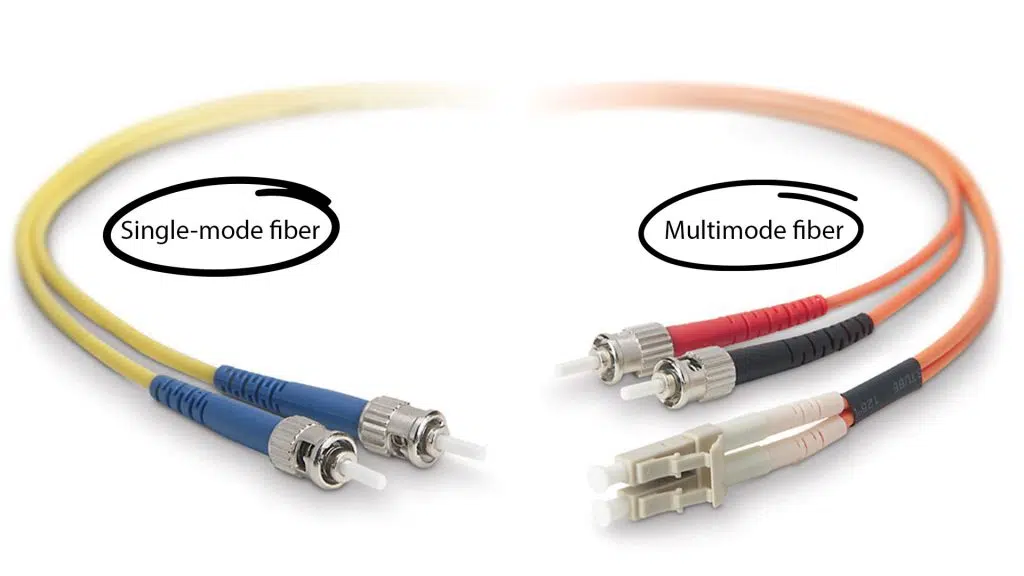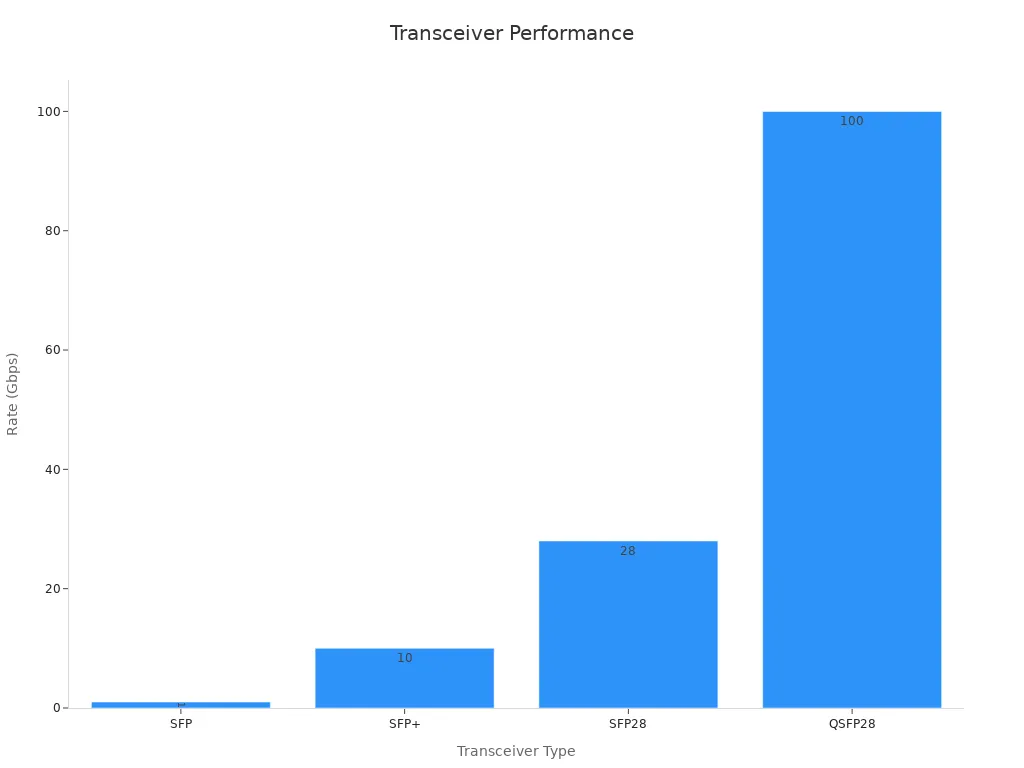
Single mode fiber optic cable and multi-mode fiber optic cable serve distinct purposes, making them incompatible for interchangeable use. Differences such as core size, light source, and transmission range affect their performance. For instance, multi-mode fiber optic cable uses LEDs or lasers, while single mode fiber optic cable employs lasers exclusively, ensuring precise signal transmission over long distances in applications like fiber optic cable for telecom and fiber optic cable for FTTH. Improper usage can lead to signal degradation, network instability, and higher costs. For optimal performance in environments like fiber optic cable for data center applications, selecting the correct fiber optic cable is essential.
Key Takeaways
- Single-mode and multi-mode cables are used for different tasks. You cannot swap them. Pick the right one for your needs.
- Single-mode cables work well for long distances and high data speeds. They are great for telecom and data centers.
- Multi-mode cables cost less at first but can cost more later. This is because they work for shorter distances and have lower data speeds.
Technical Differences Between Multi-Mode and Single-Mode Cables
Core Diameter and Light Source
The core diameter is a fundamental distinction between multi-mode and single-mode cables. Multi-mode cables typically have larger core diameters, ranging from 50µm to 62.5µm, depending on the type (e.g., OM1, OM2, OM3, or OM4). In contrast, single mode fiber optic cable features a much smaller core diameter of approximately 9µm. This difference directly impacts the type of light source used. Multi-mode cables rely on LEDs or laser diodes, while single-mode cables exclusively use lasers for precise and focused light transmission.
| Cable Type | Core Diameter (microns) | Light Source Type |
|---|---|---|
| Multimode (OM1) | 62.5 | LED |
| Multimode (OM2) | 50 | LED |
| Multimode (OM3) | 50 | Laser Diode |
| Multimode (OM4) | 50 | Laser Diode |
| Single-mode (OS2) | 8–10 | Laser |
The smaller core of single mode fiber optic cable minimizes modal dispersion, making it ideal for long-distance applications.
Transmission Distance and Bandwidth
Single-mode cables excel in long-distance transmission and bandwidth capacity. They can transmit data over distances up to 200 kilometers with virtually unlimited bandwidth. Multi-mode cables, on the other hand, are limited to shorter distances, typically between 300 and 550 meters, depending on the cable type. For example, OM4 multi-mode cables support speeds of 100Gbps over a maximum distance of 550 meters.
| Cable Type | Maximum Distance | Bandwidth |
|---|---|---|
| Single-Mode | 200 kilometers | 100,000 GHz |
| Multi-Mode (OM4) | 550 meters | 1 GHz |
This makes single mode fiber optic cable the preferred choice for applications requiring high-speed data transmission over extended distances.
Signal Quality and Attenuation
Signal quality and attenuation also differ significantly between these two cable types. Single-mode cables maintain superior signal stability over long distances due to their reduced modal dispersion. Multi-mode cables, with their larger core size, experience higher modal dispersion, which can degrade signal quality over extended ranges.
| Fiber Type | Core Diameter (microns) | Effective Range (meters) | Transmission Speed (Gbps) | Modal Dispersion Impact |
|---|---|---|---|---|
| Single-mode | 8 to 10 | > 40,000 | > 100 | Low |
| Multi-mode | 50 to 62.5 | 300 – 2,000 | 10 | High |
For environments requiring consistent and reliable signal quality, single mode fiber optic cable offers a clear advantage.
Practical Considerations for Choosing the Right Cable
Cost Differences Between Multi-Mode and Single-Mode Cables
Cost plays a significant role when deciding between multi-mode and single-mode cables. Multi-mode cables are generally more affordable upfront due to their simpler manufacturing process and the use of less expensive transceivers. This makes them a popular choice for short-distance applications, such as within data centers or campus networks. However, single mode fiber optic cable, while initially more expensive, offers long-term cost efficiency. Its ability to support higher bandwidth and longer distances reduces the need for frequent upgrades or additional infrastructure investments. Organizations prioritizing scalability and future-proofing often find the higher initial cost of single-mode cables worthwhile.
Applications of Single Mode Fiber Optic Cable and Multi-Mode Cables
The applications of these cables vary based on their technical capabilities. Single mode fiber optic cables are ideal for long-distance communication, such as in telecommunications and high-speed data centers. They maintain signal integrity over distances up to 200 kilometers, making them suitable for backbone networks and high-bandwidth applications. On the other hand, multi-mode cables, particularly OM3 and OM4 types, are optimized for short-distance use. They are commonly deployed in private networks and data centers, supporting data rates up to 10Gbps over moderate distances. Their larger core diameter allows for efficient data transmission in environments where long-distance performance is not required.
Compatibility with Existing Network Infrastructure
Compatibility with existing infrastructure is another critical factor. Multi-mode cables are often used in legacy systems where cost-effective upgrades are necessary. Their compatibility with older transceivers and equipment makes them a practical choice for maintaining existing networks. Single mode fiber optic cable, however, is better suited for modern, high-performance networks. Its ability to integrate with advanced transceivers and support higher data rates ensures seamless operation in cutting-edge environments. When upgrading or transitioning, organizations must evaluate their current infrastructure to determine which cable type aligns with their operational goals.
Transitioning or Upgrading Between Multi-Mode and Single-Mode
Using Transceivers for Compatibility
Transceivers play a crucial role in bridging the gap between multi-mode and single-mode cables. These devices convert signals to ensure compatibility between different fiber types, enabling seamless communication within hybrid networks. For instance, transceivers like SFP, SFP+, and QSFP28 offer varying data transfer rates, ranging from 1 Gbps to 100 Gbps, making them suitable for applications such as LANs, data centers, and high-performance computing.
| Transceiver Type | Data Transfer Rate | Typical Applications |
|---|---|---|
| SFP | 1 Gbps | LANs, storage networks |
| SFP+ | 10 Gbps | Data centers, server farms, SANs |
| SFP28 | Up to 28 Gbps | Cloud computing, virtualization |
| QSFP28 | Up to 100 Gbps | High-performance computing, data centers |
By selecting the appropriate transceiver, organizations can enhance network performance while maintaining compatibility between cable types.
Scenarios Where Upgrades Are Feasible
Upgrading from multi-mode to single-mode cables is often driven by the need for higher bandwidth and longer transmission distances. However, this transition presents challenges, including technical constraints and financial implications. Civil works, such as installing new ducts, may be required, adding to the overall cost. Additionally, connectors and patch panels must be considered during the upgrade process.
| Aspect | Multi-Mode Cables | Single-Mode (AROONA) | CO2 Savings |
|---|---|---|---|
| Total CO2-eq for production | 15 tons | 70 kg | 15 tons |
| Equivalent trips (Paris-New York) | 15 return trips | 0.1 return trips | 15 return trips |
| Distance in average car | 95,000 km | 750 km | 95,000 km |
Despite these challenges, the long-term benefits of single mode fiber optic cable, such as reduced signal attenuation and scalability, make it a worthwhile investment for future-proofing networks.
Dowell Solutions for Transitioning Between Cable Types
Dowell offers innovative solutions to simplify the transition between multi-mode and single-mode cables. Their fiber optic patch cables significantly enhance data speed and reliability compared to traditional wiring systems. Additionally, Dowell’s bend-insensitive and miniaturized designs ensure durability and efficiency, making them ideal for modern high-speed networks. Collaborating with trusted brands like Dowell ensures that network upgrades meet industry standards and remain compatible with evolving technologies.

By leveraging Dowell’s expertise, organizations can achieve seamless transitions while optimizing network performance and reliability.
Multi-mode and single-mode cables serve distinct purposes and cannot be used interchangeably. Choosing the right cable depends on distance, bandwidth needs, and budget. Businesses in Shrewsbury, MA, have improved efficiency by transitioning to fiber optics. Dowell offers reliable solutions, ensuring seamless transitions and scalable networks that meet modern demands while enhancing data security and performance.
FAQ
Can multi-mode and single-mode cables use the same transceivers?
No, they require different transceivers. Multi-mode cables use VCSELs or LEDs, while single-mode cables rely on lasers for precise signal transmission.
What happens if the wrong cable type is used?
Using the wrong cable type causes signal degradation, increased attenuation, and network instability. This can lead to reduced performance and higher maintenance costs.
Are multi-mode cables suitable for long-distance applications?
No, multi-mode cables are optimized for short distances, typically up to 550 meters. Single-mode cables are better for long-distance applications exceeding several kilometers.
Post time: Apr-10-2025
